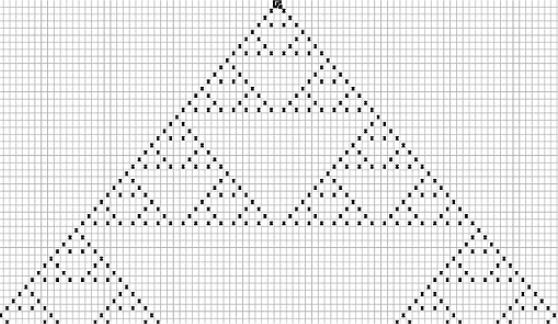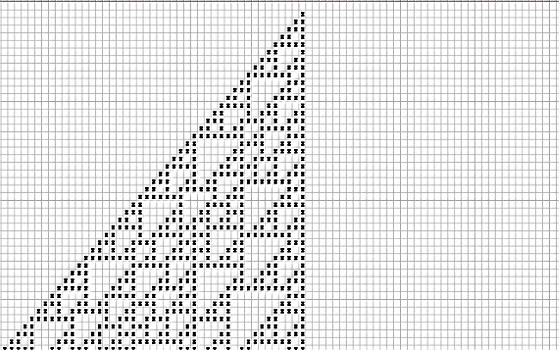|
A New Kind of
Spreadsheet
Cellular Automata Invade Our
Favorite Business Tool...
When it hit the bookstore shelves not too long ago, I was at the head of
the line to buy Stephen Wolfram’s self-published book, "A New Kind of Science"
(Wolfram Media, 2002) – possibly, you were there too. Myself, I hardly winced
at the $69.95 sticker, since that is a small price to pay for a chance to
enter the mind of a bona fide genius. A MacArthur award winner,
originally educated in theoretical physics at Eton, Oxford and Caltech,
Wolfram created the widely used software system Mathematicatm.
He has used the profits from his software company to fund his lifelong pursuit
of pure science in the fields of systems theory, mathematics, biology and
computer science – using his own invention, Mathematicatm,
as a tool to help his explorations along.
In trying to understand how complexity can derive from simple systems and
programs, Wolfram spent some years studying "cellular automata". These are
sets of cells, wherein each cell transforms itself sequentially according to
the state of its neighbors. The cells obey a very small set of pre-programmed
rules – a simple transformation protocol. So, for example, a cell will become
white if it sees 3 other black cells residing in the 3 cell locations
immediately above it (i.e., to its NW, N and NE). But it will become black if
there are only 2 black neighbors in those 3 cells, say, residing in its N and
NW directions. As in this example, the cellular scheme that Wolfram
investigated early on was composed of a single, 1-d, horizontal line of cells.
The result of each cell’s transformation was placed on the next horizontal
line directly underneath that cell, and so on as the pattern grew and changed.
(John Conway’s old computer game called Life worked the same way,
except it operated on a 2-d field.) For his 3-adjacent-neighbor example,
Wolfram established a way of defining the protocol graphically, with the 8
possible states of the neighboring 3 cells above, and the resulting transform
state below:

In this model, there are 256 possible transform rule combinations (28). The
one above is labeled "Rule 90" by Wolfram. When carried out, it produces a
pattern of nested triangles. Other rules created complex, unpredictable
patterns. One of these is Rule 110. Incredibly, Rule 110 has been shown to be
able to emulate a Universal Computer (Turing Machine)! Here is its transform
protocol:

When I read this early section of the book, I was struck by the simplicity
and elegance of this rule format. It occurred to me that it was so simple, it
ought to be able to be represented and carried out on a computer spreadsheet.
After all, I knew you could nest a total of 7 "IF" statements in MS Exceltm,
and given that there are 8 transform states in this particular cellular
automata model, that might be enough to define and control it – the 8th
state becoming the final "default" condition.
My poor peanut brain is subject to overload whenever I do Exceltm
statement nesting, and I got a real rip-snorter of a headache before I finally
got my parentheses correct. Here is how I ended up. I first defined the
transform protocol in a group of spreadsheet cells, in the same format as
shown above. I used a character "X" to represent a black cell, and a blank for
a white one:

The B4 cell master formula is as follows (be careful you don't
snag your pants leg on those parentheses):
=IF(LEFT(A3)<>"",
IF(LEFT(B3)<>"",
IF(LEFT(C3)<>"",LEFT($B$2),LEFT($E$2)),
IF(LEFT(C3)<>"",LEFT($H$2),LEFT($K$2))),
IF(LEFT(B3)<>"",
IF(LEFT(C3)<>"",LEFT($N$2),LEFT($Q$2)),
IF(LEFT(C3)<>"",LEFT($T$2),LEFT($W$2))))
Set the transform protocol rules in row 2 -- the black (X) or white (blank)
result of each of the 8 "neighbor states" -- and copy the master formula from
cell B4 into a big area of the spreadsheet. Enter an "X" in a cell up near the
top middle of your copied area to "seed" it. The cellular automata "history
tree" will unfold below it:


As a postscript, I have to say that I got bogged down a bit
before I finished the book -- it is a long one -- but I did slog through it
all. The "notes" section in the back occupies close to a third of the total
pages, and this (to me) was the most interesting reading. I think Wolfram's
point is that biological systems -- you and me -- are made up of billions of
simple cellular units, and those individual units don't really need lots of
rules or "intelligence" to operate. But the output of their collective
congress can produce fantastic complexity when viewed as a whole. In the final
analysis, that unpredictable and wonderfully symphonic system behavior ends up
being the epiphenomenon we call "I".
|
